How to Fix Heat Damaged Hair in 9 Steps

Heat tools are the answer to some of the most covetable hairstyles out there – from super-sleek, straight strands, to voluminous blow-dries, to bouncy, defined curls. But the ease, speed and effectiveness of heat styling can come at a cost to your clients; heat damaged hair is an all-too-common problem for those who love to style regularly. The good news is, while you can't reverse frazzled hair, you can work to rehydrate it and, over time, restore it back to health.
It may not be a quick process, but with a few trims and the tricks below, your client's heat damaged hair will start to look healthy and hydrated once more…
How Badly Does Heat Damage Hair?
Why is heat so damaging to hair health? It all comes down to the make-up of the hair shaft. Each one relies on natural, essential oils to stay hydrated and strong against daily wear and tear. When your client applies extreme heat to these strands – especially without a heat protectant – the natural oils on the surface may be stripped away, leaving the hair cuticle vulnerable.
This is when high porosity hair can kick in. Without those protective oils, gaps and tears can form along the cuticle, and they work a little like the holes you see in a sponge. They're able to take in a lot of moisture (like a hair mask) but they can't retain it, meaning your client's favourite hair care products can't work as effectively. These gaps may also allow hair colour pigment to escape, leaving locks brassy. And then, the longer your client goes without treating the damage, the worse the damage becomes – leading to these signs...
The Telltale Signs of Heat Damaged Hair
1. Dryness and Dullness
The very first signs of heat damaged hair are usually dryness and dullness. Your client might notice their locks take on a brittle, straw-like texture due to extreme moisture loss. Meanwhile, if their hair colour is fading due to high porosity or stripping of strands, dullness and brassiness can appear.
2. Split Ends and Breakage
Those dried-out vulnerable cuticles can start to lift and snap, leaving your client with split ends and hair breakage through the lengths. If the hair becomes too broken, it can start to look thin and untidy, with frizz making it less manageable to style and care for.
3. Excess Tangles
The drier and frizzier hair becomes, the more it will be prone to tangles. If your client can't glide a brush or comb as easily through their hair, this is yet another sign of heat damage. Some level of tangling is normal due to daily wear and tear, but when hair becomes a challenge to tame, emergency care is needed.
So, How Do You Fix Heat Damaged Hair?
1. Get Broken Ends Trimmed Off
Split ends are common when hair has been stressed out by heat styling, so is it best to cut off heat damaged ends? The simple answer is 'yes'. Your first (and most effective) course of action should be to give your client's hair a trim. As long as the damage hasn't worked its way too far up the hair shaft, you may be able to tidy split ends without taking off much length, thanks to a cutting technique known as ‘dusting'. This quick trick sees ragged strands targeted, and only the very tips trimmed off, allowing your client to keep their signature style – sans those dry, straggly ends. However, you may need to cut off a little bit more if the hair is deeply damaged. Just remind your client that it will grow back, and this is their chance to give their hair a fresh start.
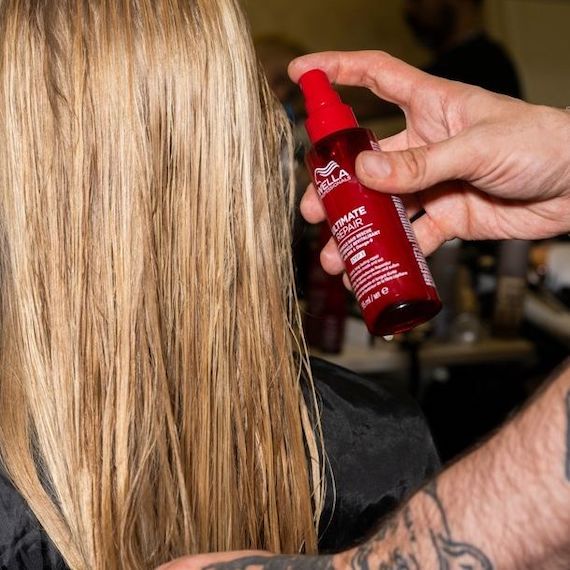
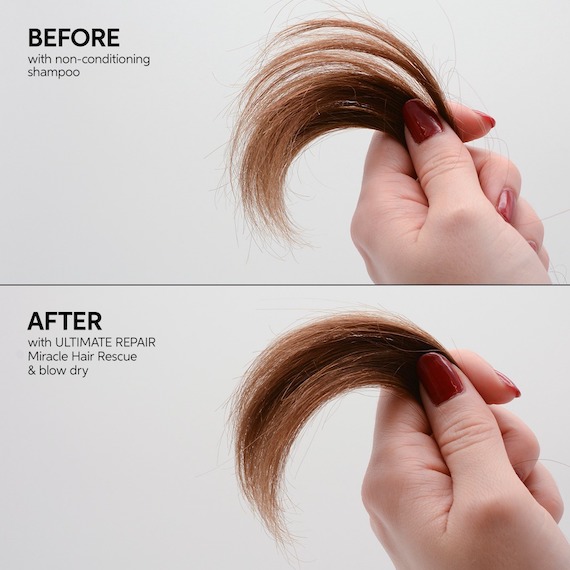
2. Give Damaged Hair Intensive Repair
Once those untidy ends are gone, it's time for your client to overhaul their care regimen. What they need is a product line-up that repairs their hair, while preventing any future damage to locks. By turning to skincare-inspired formulas, they can give their fragile strands the same level of nourishment usually reserved for delicate complexions. Think deeply hydrating and restorative, with hard-working ingredients that deliver fast results.
ULTIMATE REPAIR has heat damaged hair covered, featuring a blend of AHA to repair the internal bonds, and Omega-9 to replenish the outer layer. Advise your client to make the ULTIMATE REPAIR Shampoo and ULTIMATE REPAIR Conditioner their hair wash day staples, and even the driest locks will feel smoother, softer and beautifully hydrated from one wash to the next. Then they should mist clean, damp hair with ULTIMATE REPAIR Miracle Hair Rescue, a leave-in treatment that repairs damage in just 90 seconds*. Suitable for all hair types, from straight to coily, it gives your client 12x smoother hair** and 99% less breakage***.
3. Mix a Bond-Building Treatment Into Colour Formulas
Just because your client has heat damaged hair doesn't mean they can't embrace colour. As long as their hair isn't snapping off, lightening and toning is still possible with the help of a bond-building treatment. But first you need to ask yourself: would I still recommend colouring this client’s hair without a bond builder? If the answer is ‘no’, their locks need time to repair. If the answer is ‘yes’, turn to WellaPlex.
WellaPlex is our strengthening program that reinforces locks during the lifting and colouring process. All you have to do is mix the WellaPlex No1 Bond Maker directly into your formulas – or, if you're lightening, use BlondorPlex, which already has the Bond Maker built in. Then, after the hair has developed, rinse with the No2 Bond Stabilizer, which will neutralize locks and complete your client's service.
You can then send your client home with the WellaPlex No3 Hair Stabilizer. It's an intensive treatment they should apply weekly to keep building up the strength of ravaged strands. Show them how to use it after shampooing hair, making sure you squeeze out excess water first, so their locks can absorb as much of that strengthening goodness as possible. Leave it on for 10 minutes, then rinse thoroughly.
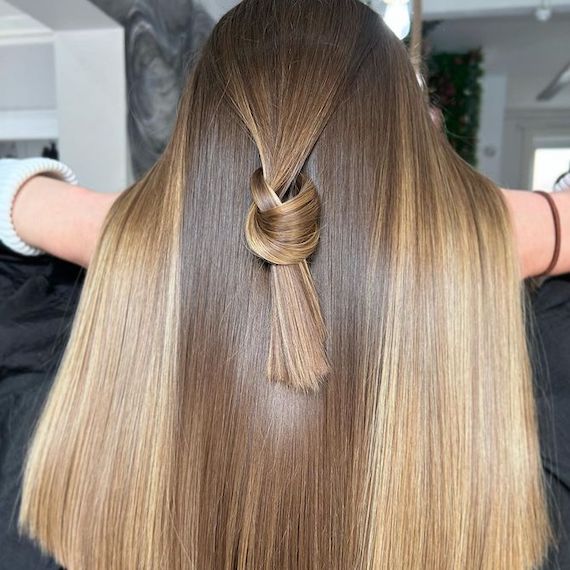
Image Credit: @sophieshairgram
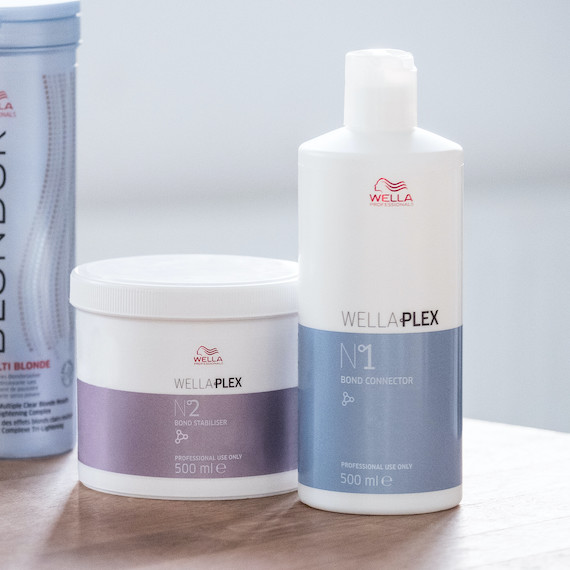
4. Be Gentle When Washing and Styling
Any kind of hair damage requires you to be a little gentler when washing and styling your client's hair. You don't want to be tugging or rubbing, as the added friction can make locks even more knotted and frayed. Keep this in mind when it comes to using shampoo and conditioner, and take the time to delicately smooth products through. Your client will thank you in the long run.
It's especially important to be careful when working through the mid-lengths and ends of hair, as these sections experience the biggest brunt of repeated heat damage (more so than those newly grown roots). That gentle touch extends to combing out tangles, too; you should tease out knots in small sections, starting from the bottom first, then gradually working your way up to the roots.
5. Style With Nourishing Oils and Lotions
As well as adding extra hydration to their everyday care routine, your client can also level up moisture with 2-in-1 stylers that enhance nourishment. Some of our favourites for care and styling include a drop of the gloss-boosting Oil Reflections Luminous Smoothing Oil, layered with the protective EIMI Flowing Form blow-dry balm. Both are moisturizing and make locks more manageable, so strands are softer and easier to style. If your client has fine or thin hair, recommend the Elements Renewing Leave-In Spray, which has a light, liquid-like texture that won't drag styles down. Meanwhile, heat damaged curls craving hydration will appear glossier and more defined with a generous dose of the NutriCurls Curlixir Balm. Scrunch it in to really shape those curves.
6. Opt for Heat-Free, Low-Tension Hairstyles
Scaling back on heat styling is crucial for heat damaged hair, but that doesn't mean your client has to compromise on frizz-free locks. They should simply embrace heat-free coiffing with the styling products above. On hair wash day, tell them to apply their chosen oil, lotion or balm through the mid-lengths and ends of hair, then twist into a low, loose bun or braid for waves, or plop their hair overnight to boost the shape of curls.
They could even try the #treatmentbun trend that’s taking off on TikTok right now, which sees damaged hair treated to a generous dose of nourishment, like Miracle Hair Rescue, and set in a sleek bun. Another option is heatless curling, where slightly damp or dry hair is wrapped around a foam curler overnight, then released in the morning to reveal loose, tumbling curls. The goal is for your client to air-dry their hair with a low-tension style, so their strands won't snap. That means making sure any braids or twists they create aren't pulling on those fragile lengths.
The type of ties and clips they use for these styles is important too, so remind them to reach for soft, silky scrunchies, scarves and even pillowcases, which will be gentler than elastics and cotton.
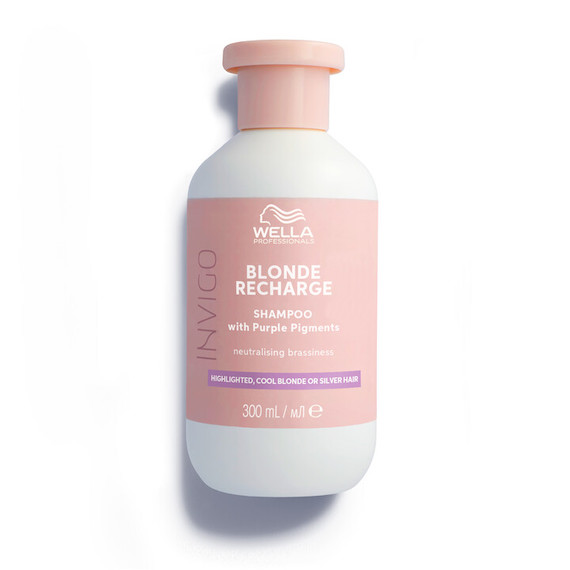
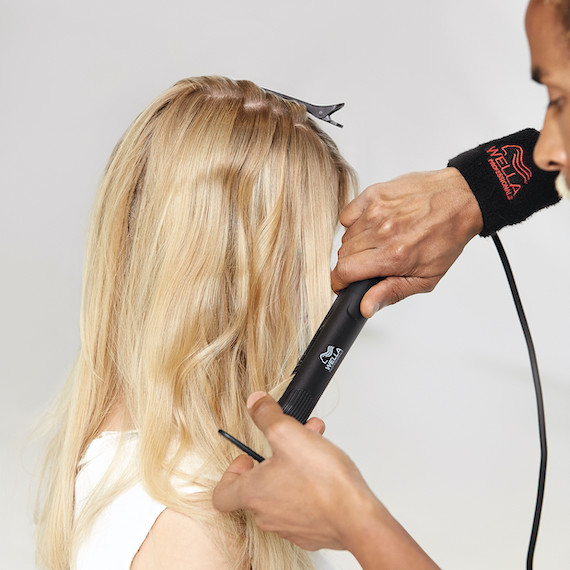
7. Banish Brassiness with a Purple Shampoo
If your client's heat damaged hair has fallen victim to brassiness, tell them not to panic. Their colour isn't ruined forever, and they can actually keep those unwanted tones at bay while in the shower. All they need is a purple shampoo, which neutralizes the excess warmth that can appear when hair is heat damaged. Recommend they try INVIGO Blonde Recharge Cool Blonde Shampoo. Massaged into wet hair and left for three to five minutes, it banishes yellow and orange tones in the hair, so your client’s colour appears fresh once more.
8. Protect From Future Heat Damage
While the steps above will help to rehydrate heat damaged curls, waves, and straight hair, they can only be truly effective if your client is safeguarding their strands from future harm. And, unless they plan to leave their hairdryer and hot tools behind for good, this means a heat protection spray is essential in their kit. Introduce them to EIMI Thermal Image, which shields locks from up to 220 degrees celsius, all while boosting shine in a weightless mist. This should be the last product they apply before they turn up the heat, so remind them to always spray it on after applying any serums, oils, or balms.
9. Turn the Temperature Down
Your client may be blow drying, straightening or curling their hair on a higher heat setting than needed, so encourage them to turn the temperature down – especially if their hair is thin or fine. The optimal temperature when styling thin or fine hair is 250°F - 300°F (120°C - 150°C), and for thick, coarse hair, it can go up to 350°F - 450°F (180°C - 230°C). So, recommend a low to medium heat setting on their blow dryer, and hot tools that allow them to adjust the temperature, like the Style Hair Straightener.
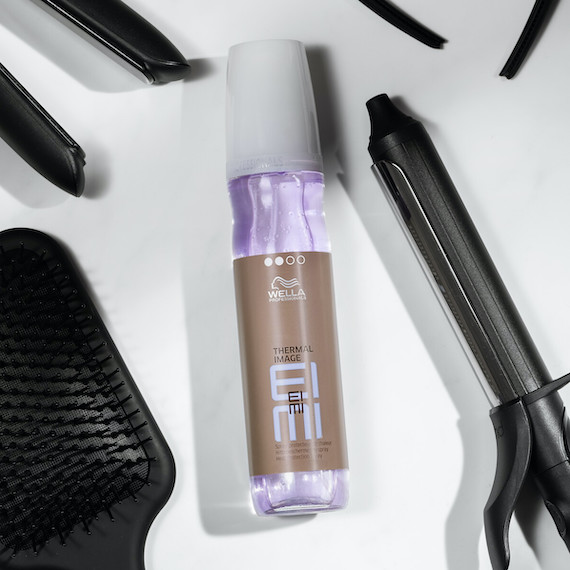

Image Credit: @kazdoeshair
How Long Does it Take to Repair Heat Damaged Hair?
Once your client has all the steps above in motion, their hair will be on the right track for repair. However, how long it takes to achieve healthy locks will depend on how bad the heat damage was. In most cases, simply snipping off the breakage and investing in extra nourishing care will have instant results. But, that doesn't mean their hair will be 100% restored from root to tip; this process can take around two months or more. What's important is that they keep consistent with their new, reparative regimen, so the look, feel and condition of their locks gets better and better. Heat damage will soon be history.Looking for more ways to help your client care for their hair? Discover our complete collection of Hair Care Guides, featuring tips for every type and concern.
* When using ULTIMATE REPAIR Miracle Hair Rescue.
** Vs. non-conditioning shampoo.
*** When using ULTIMATE REPAIR Miracle Hair Rescue. Instrumental test versus non-conditioning shampoo.



